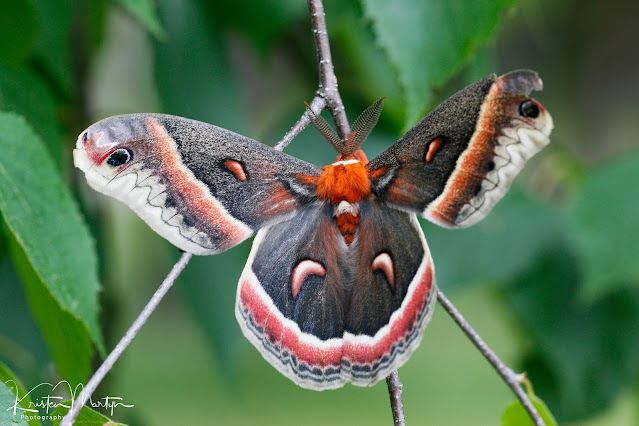Many people regard butterflies as stunning, delicate, and beautiful creatures. Their counterparts, moths, often don't carry the same reputation -- perhaps because they come out at night! Moths are far more numerous species wise than butterflies. In Ontario alone we have over 300 species of moths. They are nocturnal, often duller than butterflies and as you probably know - attracted to light!
Ontario is home to some pretty spectacular moth species. To make them seem a little less 'scary' and a little more magnificent, I'm going to profile a few for you.
Cepropia Moth
This is the largest species of moth we have in Ontario. Aren't they striking?! Their colouration and patterning includes eyespots, which essentially evolved for intimidation, it deters predators by making them think they are potentially facing a larger, more dangerous species. This species is considered a silk moth, and the silk they use to make cocoons can technically be used to make silk clothing, though silkworms are used for almost all silk used in clothing.
 |
Cepropia Moth. Photo by Kristen Martyn.
|
| Cepropia Moth. Photo by Kristen Martyn. |
Luna Moth
Luna moths are typically found in forested areas. For silk moths, such as Luna and Cepropia, males have much longer antennae than female which is one way they can be distinguished from each other. The reason for this is that males use these antennae to detect pheromones put out by females. Although not always obvious in certain lights, their pale green bodies are contrasted by pink edges.
 |
| Luna Moth. Photo by Shayna Hartley. |
.jpg) |
| Luna Moth. Photo by Shayna Hartley. |
Hummingbird Clearwing Moth
Not only do these moths look similar to hummingbirds, the way they feed mimics their behavior as well. They are typically out in the daytime, unalike most other moth species, have rapid wing beats AND probes for nectar at flowers. They are often mistaken for hummingbirds or believed to be "baby hummingbirds". They will seek nectar from thistles, bergamot, lilac, beebalm, and Japanese honeysuckle. Growing these plants (or leaving thistle) is a good way to attract them. Many spot them in their own gardens!
 |
| Hummingbird Clearwing Moth. Photo by Kristen Martyn. |
 |
| Hummingbird Clearwing Moth. Photo by Kristen Martyn. |
I could feature hundreds of other moths, but I hope this brief overview of some very striking, interesting - and day roaming!- moths, has at the very least incited a 'wow' and convinced you that moths are in fact, pretty cool.
See if you can find any of these marvelous moths!
Warmly,
Heather


.jpg)



















No comments:
Post a Comment